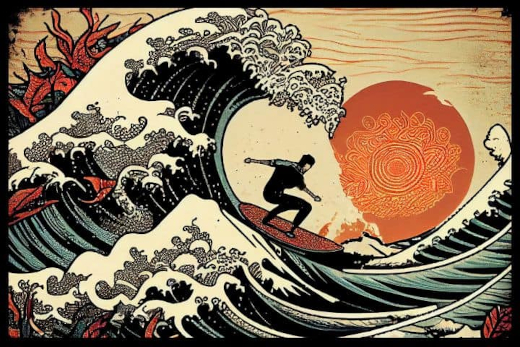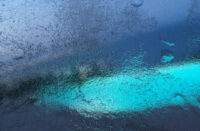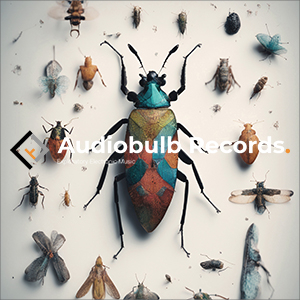Through multiple evolutions along decades, with a refined combination of harmonies, a deep sense of space, a phenomenology of time and bright sonic manipulations based on acoustic timbres, Japanese artists invite the listener to enlightened and intuitive inner promenades.

The poetry of space
at dusk
i often climb
to the peak of kugami.
deer bellow,
their voices
soaked up by
piles of maple leaves
lying undisturbed at
the foot of the mountain.
~Taigu Ryokan
From his genesis to his latest development at the digital era, ambient music defends the idea of spiritual comfort and oceanic feeling; in resonance with “perfumed” sounding atmosphere, as David Toop said when he relates to suggestive pleasures and aether talks. Ambient music is a state which inspires us a more dignified and magical views on our every day life. Whatever its declination into subcategory as house ambient, chill-out, downtempo, and dark ambient, the listener is irresistibly moved to the confines of a “poetry of space” (Bachelard) which come from distant electronic winds. The poetry of space and the aesthetic-ethical value of environment are central in the primordial philosophy of Japan where every life or mental movement can be the subject of an inward spiritual ecstasy, a reason to dive in a vast oceanic world, synonym of liberation and reflective peacefulness.
The poetical and existential relationship with space is traditionally governed by a practical science of milieu (fudo), a relational more than a substantial ontology also is careful to seasonal moves and a singular sense of situations which relate to human being interaction with nature as a whole. This ontology forged by antique principles is nowadays violently in construct with neoliberal symmetric urban ecology also established in modern Japan. In ambient music the sound artist is attentive to spiritual narratives and energies blooming in natural vastness, multilayered worlds more than to heavy formalistic rhetorics.
The “oceanic call” conceptualized in the Ukiyo, day dreaming and devotion/surrendering to the sovereign Nature heal the soul and maintain a slow heart pulse which is after all a quest for an inner harmony. In this regard Japanese ambient music has deep roots into cultural, philosophical idiosyncrasies. The musical adventure turns into a deep meditative estate where mental processes, consciousness flux are deeply activated while the body escapes from its materiality through an ascetic form of stillness.
Without going much into esoteric concepts the whole idea of Japanese ambient music assumes a coordination between internal and external spaces which might be effective through breath, silence and openness. In other words, music is understood as a ritualized vehicle to initiate a potential restored self, the musical experience goes through subtle and rich textures, radiant tone colors which evolve slowly, gradually, sometimes almost imperceptibly for the ordinary listening experience (this particularly noticeable in the lowercase sub-genre, where micro noises, micro rhythms are used as sinuous paintings, this was approached by the Onkyokei scene headed by Nakamura and other artisan of electroacoustic music researches.
The delicate regard on silence ::
The micro details are a component regarding Japanese faith in Nature and ordinary poetry, it is particularly eloquent in the brief haiku writing form, in Shinto beliefs, in foundational Zen treaties opened to silent meditation on the time which passes by Dôgen, chômei, Kenkô, Shônagun (et al) in impressionist descriptions of the hyper perceptive literary school (Kawabata), in the highly sensitive philosophical novels of Junichiro Tanizaki. The delicate regard on silence, slowly moving elements, the intangible inspired by non west traditional music and in particular Japan was evident in some pierces of New Yorkers innovating musical spirits and avant-garde personalities such as Henry Cowell or John Cage (even if his aleatoric method of composition was directly inspired by the Chinese Yi-King).
The influence of Japanese ritual and traditional music on the imaginary landscapes forged by the minimalist and proto ambient music scene comes from Gagaku (oldest manifestation of Japanese music). Certainly gamelan sound ritualism and the raga Kirana popularized by La Monte Young in his luminous dreamily microtonal sound installations had a deep impact in the development of ambient music archetypes but the search of subliminal tranced out estate through repetition and acoustic vibrations we can find in Gagaku codified court music is also worth of consideration. Even modern days digital ambient artists such as Tim Hecker, Gabriel Saloman or Fabio Perletta found an interest in Japanese classical music for their sonic drone sculptures.
All in all ambient music made in Japan insists more than anywhere else on the enlighten properties of sound colors, sound symbolism with references to antique refinement and meditative beauty accessible in deep dreamily connection with Nature. The intention is to install an intuitive experience of spiritual sound ecology in the mind of the sound traveler and in the heart of the listener sensitive to poetical photographers of real and imaginary spaces marked by liminality. This music also helps us to be in contact with the melancholic beauty of things. Without being exhaustive, now let’s have a look on the beautifully crafted atmospheric / harmonic swells of Japanese minimal ambient through a handful of classical albums and new phonographic discoveries.
In itself ambient music from Japan takes its genesis from early minimalism. From this school of experimental and spiritual researches for higher state of consciousness and self/collective meditation we often refer to West composers notably American ones such as Terry Riley, Charlemagne Palestine, Phil Nyblock, La Monte Young, and Pauline Oliveros, but the sense of sonic manipulations and deep spacious drone patterns were also largely explored and carried on by visionary Japanese sound artists such as Yoshi Wada, the Fluxus member Takehisa Kosugi (ex-Taj Mahal travelers). Their expanded, epic and otherworldly suspended mantras notably for long string chords and amplified technics will be an undeniable influence on generations to come. Their long form, avant-garde, and stellar improvisations were held mostly in the 70s. Among others and for an introductive experience which captures the everlasting acoustic / semi electronic power and slowly evolving tones of those Japanese pioneering spirits we can recommend the following releases:
The legendary Sub Rosa and thanks to a handful of reissues and a precious amount of sound archives also participated to make the early concrete-minimalist-challenging electronic music and post-Cage researches from Japan to be known for a wider audience. In a certain way we can also notice the presence of Tzadik (established by John Zorn) for having signed foundational materials from Teiji Ito (known for his soundtracks for surreal, theatrical and experimental film maker Maya Deren) and Oromo Yoshihide.
Starting from this preliminary statement and dedication to emblematic sound researchers who convey concrete music, processed acoustic timbres to their undulating sonic sounds sculptures we can now talk about the first wave of ambient music from Japanese underground and meditative subculture.
Among early Japanese venturing sound artists in the field of free-floating ambient music with now a whole architecture based on modern synth equipment and electronic devices we can name Hiroshi Yoshimura whose pioneering work and its specific sound (spiritual) ecologic qualities are distinguished as Kankyo Ongaku (Environmental music). His music is characterized by the use of simple repetitive motifs, acoustic elements, electronic droning chords, and various green field recordings for an embalming, calming and mellow result, sometimes including Japanese traditional music harmonies, sort of yoga of sounds, not really into hybrid new age philosophy but with roots in antique beliefs from Japanese cultural cradle. This approach opens the way to a generation of sound artists found of psych-acoustic effects, sonic explorations and elevated meditative moods.













![Pole :: Tempus Remixes (Mute) — [concise]](https://igloomag.com/wp/wp-content/uploads/2025/04/pole-tempus-remixes_feat-75x75.jpg)






![Hasbeen :: Bunker Symphonies II (Clean Error) — [concise]](https://igloomag.com/wp/wp-content/uploads/2025/04/hasbeen-bunker-symphonies-ii_feat-75x75.jpg)

